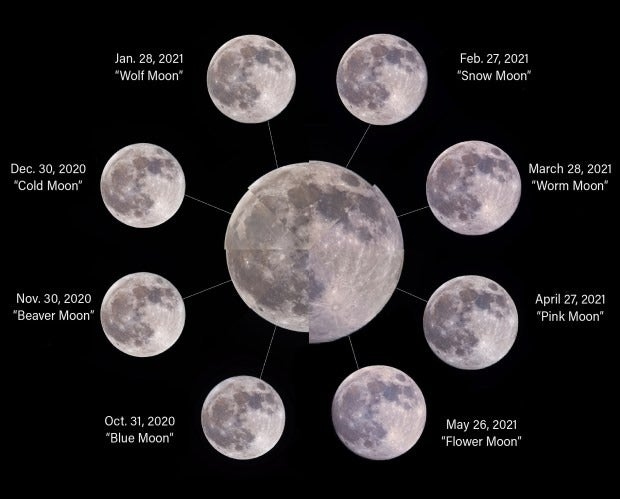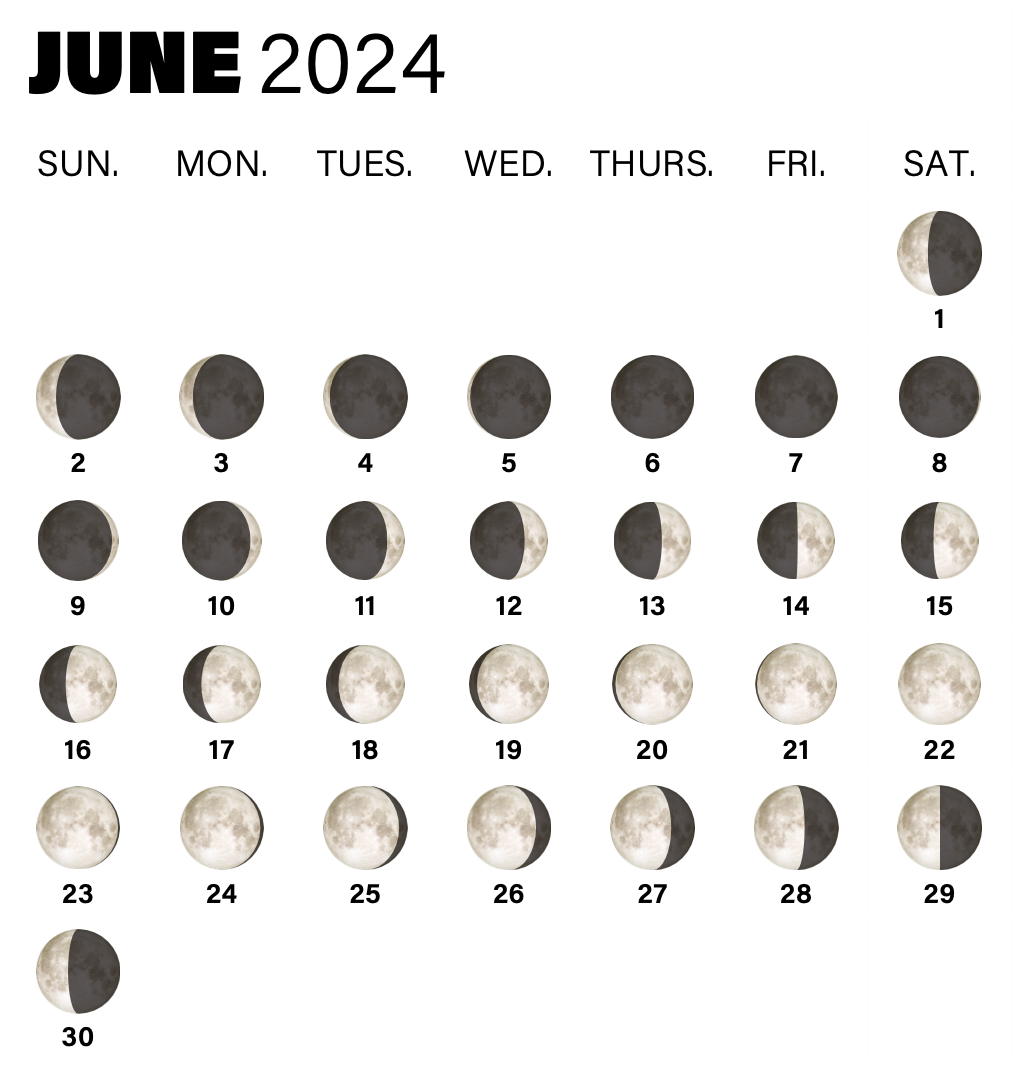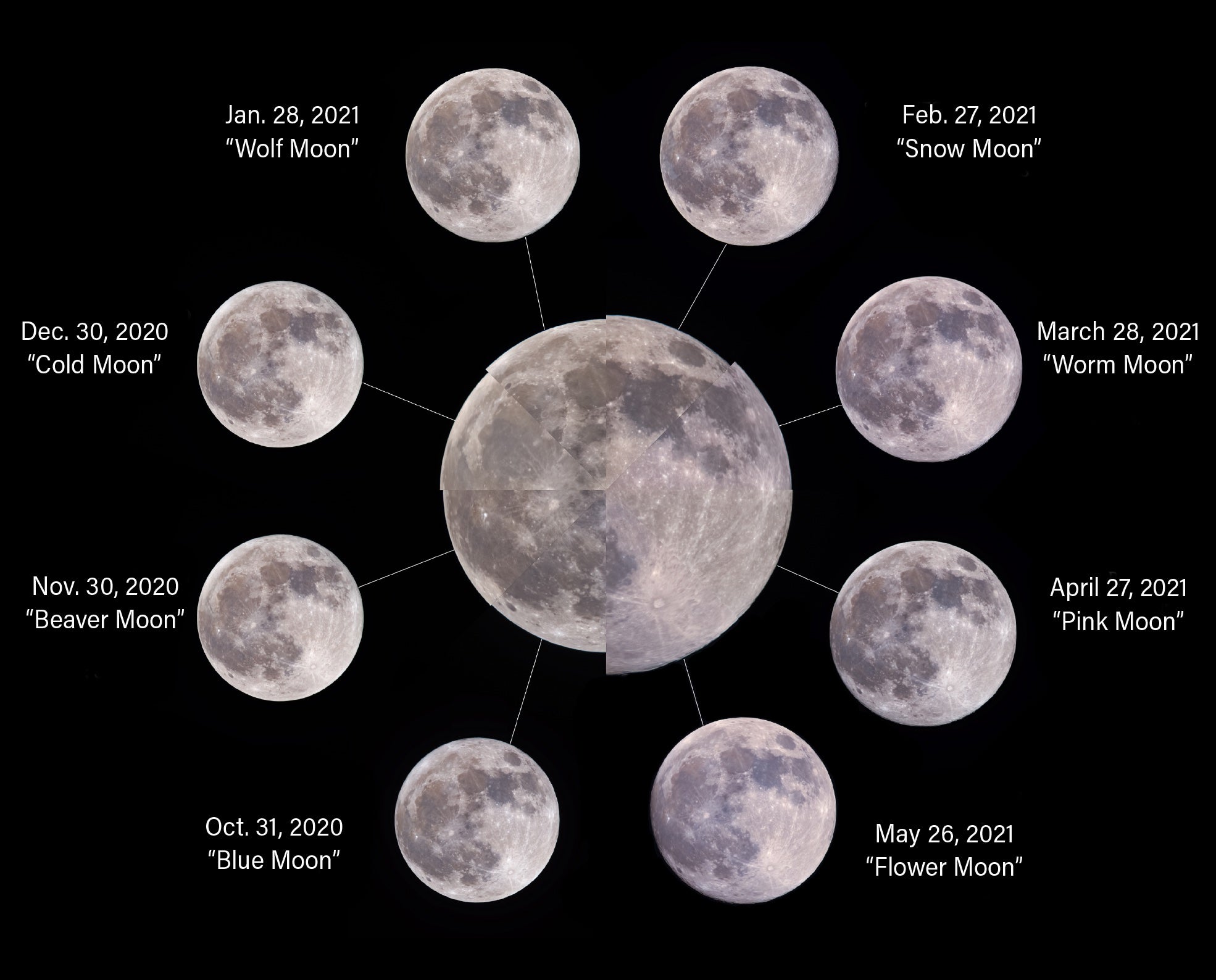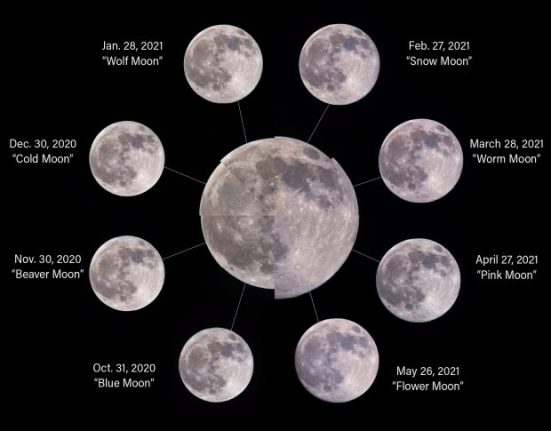
A composite image showing the Full Moons in 2020 and 2021 by month. Credit: Soumyadeep Mukherjee.
The Full Moon phenomenon arises when our planet, Earth, is precisely sandwiched between the Sun and the Moon. This alignment ensures that the entire side of the Moon facing us shines in the sunlight. Thanks to the Moon's orbit around the Earth, the angle of sunlight that hits the lunar surface and is reflected back to our planet changes. That creates different lunar phases.
The next Full Moon in 2024 will be at 9:08 p.m. ET on Friday, June 21 and it's called Strawberry Moon.
We'll update this article several times a week with the latest moon rises and moon sets, the full moon calendar, and some of what you can see in the sky each week.
Here is the complete list of this year's Full Moons and their traditional names.
Full Moon Calendar of 2024 and names of each one
(all times Eastern)
- January 25 – 12:54 pm – Wolf Moon
- February 24 —7:30 am — Snow Moon
- March 25 – 3 am – Worm Moon
- April 23 – 7:49 pm – Pink Moon
- May 23 – 9:53 am – Flower Moon
- Friday, June 21 – 9:08 pm – Strawberry Moon
- Sunday, July 21 – 6:17 am – Buck Moon
- Monday, August 19 – 2:26 pm – Sturgeon Moon
- Tuesday, September 17 – 10:34 pm – Corn Moon
- Thursday, October 17 – 7:26 am – Hunter's Moon
- Friday, November 15 – 4:28 pm – Beaver Moon
- Sunday, December 15 – 4:02 am – Cold Moon
The phases of the Moon in June 2024.
The following images show the day to day. moon phases In June. June's Full Moon is at 6:17 a.m. on Friday, June 21 and is colloquially called the Strawberry Moon.

Moonrise and moonset times this week
The following is adapted from The Sky This Week article by Alison Klesman, which you can find here.
*Moonrise, moonset, moonrise and moonset times are given in local time from 40° N 90° W. Moon illumination is given at 12 pm local time from the same location.
Friday June 14
The first quarter moon occurs at 1:18 am EDT this morning. A few hours later, at 9:35 a.m. EDT, the Moon reaches its apogee, the farthest point from Earth in its orbit. At that time, it will be 404,077 kilometers (251,082 miles) away.
Sunrise: 5:31 a.m.
Sunset: 8:30 PM
Moonrise: 13:26
Moonset: 1:21 a.m.
Moon phase: Growing gibbous (55%)
Saturday June 15
Let's take a look at June's parade of planets in the morning sky.
Sunrise: 5:31 a.m.
Sunset: 20:31
Moonrise: 14:24
Moonset: 1:40 a.m.
Moon phase: Growing gibbous (64%)
Sunday June 16
The Moon passes 1.2° north of Spica at 2 pm EDT.
Sunrise: 5:31 a.m.
Sunset: 20:31
Moonrise: 15:25
Moonset: 02AM
Moon phase: Growing gibbous (73%)
Monday June 17
The small constellation Delphinus is rising in the east this afternoon, reaching an altitude of more than 15° around 10:30 pm local time.
Sunrise: 5:31 a.m.
Sunset: 20:31
Moonrise: 16:28
Moonset: 2:21 a.m.
Moon phase: Growing gibbous (81%)
Tuesday June 18
Comet 13P/Olbers remains relatively easy to detect at small range, passing close to the globular cluster NGC 2419 in Lynx tonight.
Sunrise: 5:31 a.m.
Sunset: 20:32
Moonrise: 17:34
Moonset: 2:45 a.m.
Moon phase: Growing gibbous (88%)
Wednesday June 19
Can you see Mercury now? The smallest planet in the solar system has jumped into the night sky, but it is an extremely challenging object: less than 2° high 20 minutes after sunset.
Sunrise: 5:31 a.m.
Sunset: 20:32
Moonrise: 18:41
Moonset: 3:15 a.m.
Moon phase: Growing gibbous (94%)
Thursday June 20
The Moon now passes 0.3° north of Antares at 7 a.m. EDT; At dusk, they are 8.5° apart as our satellite zips across the sky.
Sunrise: 5:32 a.m.
Sunset: 20:32
Moonrise: 19:49
Moonset: 3:52 a.m.
Moon phase: Growing gibbous (98%)
Friday, June 21st
If you have a telescope and an alarm clock, you can see several of Saturn's smaller moons congregating near the mighty planet's rings this morning.
Sunrise: 5:32 a.m.
Sunset: 20:32
Moonrise: 20:52
Moonset: 4:39 a.m.
Moon phase: Full
The phases of the moon
The phases of the Moon are: New Moon, Crescent Moon, Crescent Moon, Waxing Gibbous, Full Moon, Waning Gibbous, Waning Quarter, and Waning Quarter. A cycle starting from a Full Moon to its next counterpart, called a synodic month or lunar month, lasts approximately 29.5 days.
Although the Full Moon only occurs during the exact moment when the Earth, Moon, and Sun form a perfect alignment, to our eyes, the Moon appears full for approximately three days.
Different names for different types of Full Moon
There are a wide variety of specialized names used to identify different types or times of full moons. These names mainly date back to a combination of cultural, agricultural and natural observations about the Moon, which aim to allow humans to not only predict seasonal changes but also track the passage of time.
For example, the Full Moon of most months has a name from Native American, American Colonial, or other North American traditions, and its titles reflect seasonal changes and events in nature.

Wolf Moon (January): Inspired by the cries of hungry wolves.
Snow Moon (February): A nod to the heavy snowfall of the month.
Worm Moon (March): Named after the earthworms that mark melting points.
Pink Moon (April): In honor of blooming pink wildflowers.
Flower Moon (May): Celebrating the blooming of flowers.
Strawberry Moon (June): Marks the best strawberry harvest season.
Buck Moon (July): Recognize the new antlers of the goats.
Sturgeon Moon (August): It owes its name to the abundant sturgeon fish.
Corn Moon (September): It means the corn harvest period.
Hunter's Moon (October): Commemoration of the hunting season before winter.
Beaver Moon (November): Reflects the time when beavers are busy building their winter dams.
Cold moon (December): Evokes the cold of winter.
Additionally, there are some additional names for full moons that commonly appear in public conversations and news.
Large moon: This term is reserved for a Full Moon that aligns with the lunar perigee, which is the closest point of the Moon to the Earth in its orbit. This proximity makes the Full Moon unusually large and bright. For a Full Moon to earn the Super Moon label, it must be within about 90 percent of its closest distance to Earth.
blue Moon: A Blue Moon is the second Full Moon in a month. that experiences two Full Moons. This phenomenon graces our skies approximately every 2.7 years. Although the term suggests a color, blue moons are not actually blue. Very occasionally, atmospheric conditions, such as recent volcanic eruptions, can give the Moon a slightly bluish tint, but this hue is not linked to the term.
harvest moon: The Harvest Moon, which occurs closer to the autumn equinox, usually in September, is often famous for a distinctive orange tint it can display. This Full Moon rises near sunset and sets near sunrise, providing long hours of bright lunar light. Historically, this was invaluable to farmers harvesting their produce.
Common questions about full moons
What is the difference between Full Moon and New Moon? A Full Moon is observed when the Earth is between the Sun and the Moon, making the entire face of the Moon visible. In contrast, during the New Moon, the Moon is between the Earth and the Sun, shrouding its Earth-facing side in darkness.
How does the Full Moon influence the tides? The Moon's gravitational pull causes Earth's waters to bulge, generating tides. During both the Full Moon and the New Moon, the Sun, Earth and Moon are aligned, generating “spring tides”. These tides can swing exceptionally high or low due to the combined gravitational influences of the Sun and Moon.
Here are the dates of all the lunar phases in 2024:
| New | First quarter | Full | Last room |
|---|---|---|---|
| January 3 | |||
| January 11 | January 17 | January 25 | February 2 |
| February 9 | February 16th | February 24th | March 3rd |
| March 10th | March 17 | March 25th | April 1st |
| April 8 | April 15 | April 23rd | May 1 |
| May 7 | 15 th of May | may 23 | May 30 |
| June 6th | June 14th | June 21 | June 28th |
| July 5th | July 13 | July 21 | July 27th |
| August 4th | August 12 | August 19 | 26 of August |
| September 2 | 11 of September | September, 17th | 24th September |
| October 2nd | October 10th | October the 17th | October 24th |
| November 1st | November 9 | November 15 | November 22th |
| December 1st | December 8 | December 15 | December 22th |
| December 30 |













Leave feedback about this